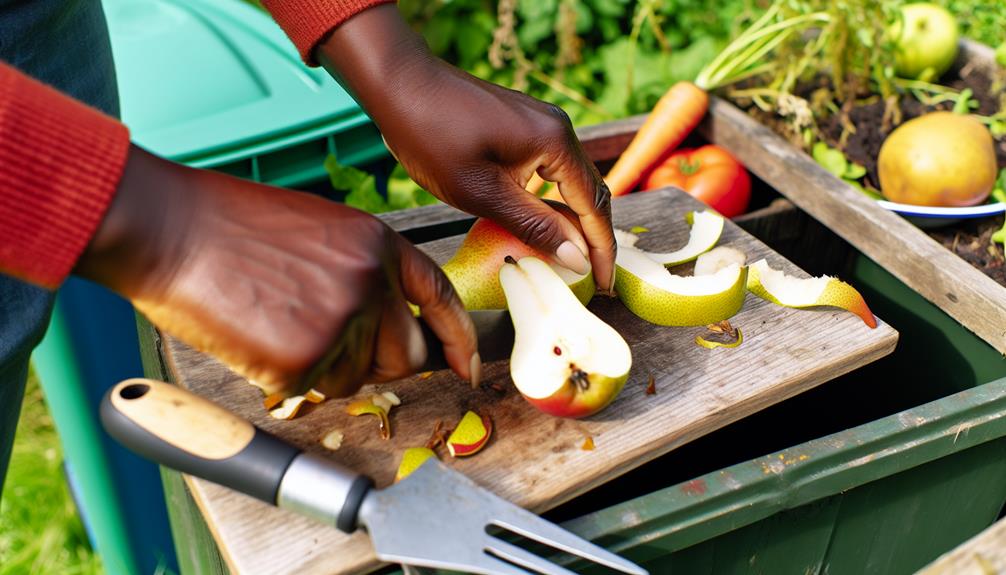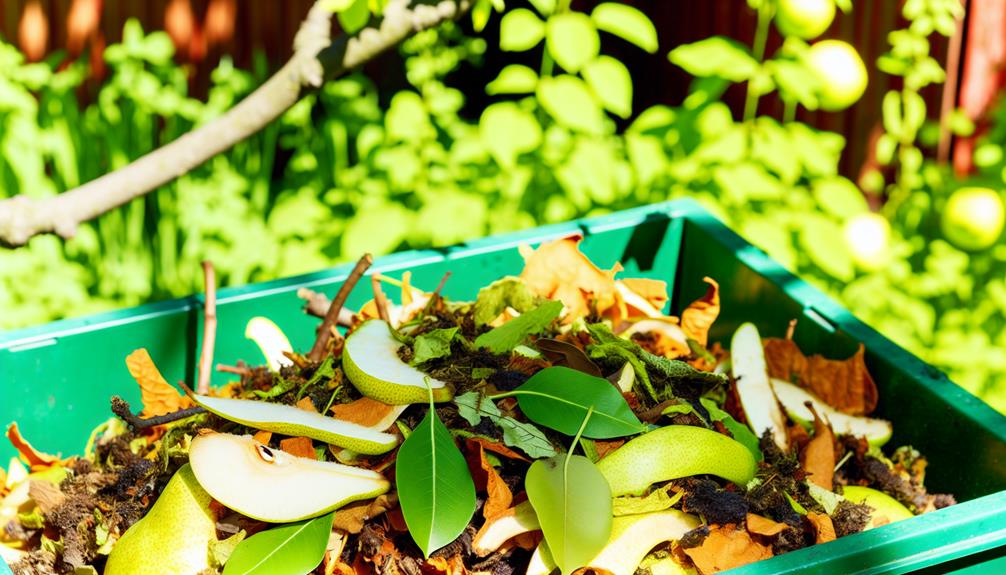

You can compost pears, and they provide great benefits. Cut them into small pieces to help them break down faster. Mix them with dry materials like leaves to balance their high moisture content. Pears have high sugar content, which speeds up decomposition, but keep an eye out for pests like fruit flies.
Regularly turn your compost pile to guarantee even moisture distribution and efficient microbial activity. Make sure you maintain a good balance of green (kitchen scraps) and brown (dry leaves) materials for best composting. For further in-depth tips and improved composting success, there’s more to explore.
Composting pears offers several benefits, including enriching your soil with essential nutrients. When you compost pears, you’re participating in nutrient recycling, a process that returns valuable minerals back to the earth. This helps create a healthy, balanced soil environment. Your garden will thrive as the compost enhances soil enrichment, providing plants with the nutrients they need to grow strong and vibrant.
To get started, gather your pear scraps and add them to your compost bin. Make sure to mix them with other organic materials like leaves, grass clippings, and vegetable peels. This mixture will break down over time, turning into rich, dark compost. Regularly turning the compost helps speed up the decomposition process and guarantees even distribution of nutrients.
As you incorporate this compost into your garden soil, you’ll notice improved soil structure and increased fertility. The organic matter from the pears boosts microbial activity, which is essential for plant health.
Adding pears to your compost has its advantages and drawbacks, which you should consider before starting.
On the pro side, pear peels and flesh decompose quickly, providing valuable nutrients to your compost pile. They add moisture and essential organic matter, which helps maintain a healthy balance in your compost. Plus, incorporating pears can reduce kitchen waste, making you feel more connected to sustainable practices.
However, there are some cons to be aware of. Pears can attract pests like fruit flies if not properly managed. Additionally, whole pears can take longer to break down compared to smaller pieces. Mold growth is another potential issue; while some mold is natural in composting, excessive mold can indicate imbalances in your pile. It’s important to maintain a proper ratio of green (nitrogen-rich) and brown (carbon-rich) materials to prevent this.
To avoid these cons, you should regularly turn your compost and monitor moisture levels. By addressing these challenges, you’ll guarantee that your composting efforts remain effective. Understanding the pros and cons of adding pears will help you make informed decisions and keep your compost pile thriving.
Also Read: Can You Compost Cat Manure?
To effectively incorporate pears into your compost, start by cutting them into smaller pieces to speed up the decomposition process. Use simple cutting techniques, such as dicing or chopping, to guarantee the pieces are no larger than an inch. This increases the surface area, allowing microbes to break down the organic material more efficiently.

If you’ve got a surplus of pears and can’t add them all to the compost at once, consider proper storage methods. Store cut pears in an airtight container and place them in the refrigerator. This keeps them from rotting prematurely, making sure they’re ready for composting when you’re prepared.
If you need to store them for a longer period, freezing is another effective method. Simply lay the cut pieces on a baking sheet to freeze individually before transferring them to a freezer bag.
Pears have a high water content, which means they can add a lot of moisture to your compost pile.
You’ll need to balance this by adding dry materials like leaves or straw to prevent your compost from becoming too wet.
Keeping an eye on moisture levels guarantees efficient decomposition and prevents any unpleasant odors.
When composting, it’s crucial to take into account the high water content in pears, as it can impact the overall moisture balance of your compost pile. Pears have a high moisture level, which means they contribute greatly to the hydration of your compost. However, this also means you need to manage water absorption carefully to maintain the right conditions for decomposition.
First, consider adding pears in moderation. Too many can make your pile overly wet, leading to a potential anaerobic environment where decomposition slows down and odors increase. To avoid this, balance the high water content of pears with drier materials.
Brown materials like leaves, straw, or shredded newspaper work well for hydration management. These materials help absorb excess moisture, ensuring your compost pile remains aerated and well-balanced.
Next, regularly turn your compost pile to enhance aeration. This practice allows for even water distribution and prevents soggy spots that can hinder the composting process. Keeping an eye on the overall moisture level is key; your compost should feel like a damp sponge, not dripping wet.
Managing the moisture levels in your compost pile is key to balancing the high water content found in pears. Too much moisture can lead to a soggy, anaerobic mess, while too little can slow decomposition. Start by using aeration techniques to guarantee proper airflow. Turn your compost pile regularly with a pitchfork or compost aerator. This helps break up clumps and introduces oxygen, which is essential for decomposition.
Next, consider moisture retention. Pears are high in water, so balance them with dry, carbon-rich materials like straw, leaves, or shredded newspaper. These materials absorb excess moisture and help maintain the right balance. Aim for a mix of one part green (moist) to three parts brown (dry) materials.
Monitor the moisture level by doing a simple squeeze test. Grab a handful of compost, squeeze it, and check the results. If water drips out, it’s too wet. If it crumbles and doesn’t hold shape, it’s too dry. Adjust accordingly by adding more browns or greens.
Also Read: Can You Compost Butter?
When you compost pears, their high sugar content can notably boost microbial activity, accelerating the breakdown process.
This rapid decomposition helps maintain a balanced compost pile by integrating with other materials.
However, you’ll need to monitor the pile to prevent any imbalance caused by excessive sugars.
The natural sugars in pears can greatly enhance microbial activity in your compost pile. These sugars act as a food source for microbes, which in turn boosts their metabolism and overall activity. This enhanced microbial activity has several benefits for your composting process.
Increased enzyme activity: The sugars in pears help microbes produce more enzymes, accelerating the breakdown of organic matter.
Enhanced nitrogen fixation: Active microbes can fix more nitrogen, making your compost richer in essential nutrients.
Improved decomposition: With more active microbes, organic materials decompose faster, resulting in quicker composting cycles.
To make the most of these benefits, chop your pears into small pieces before adding them to the compost pile. This increases the surface area, allowing microbes to access the sugars more easily. Also, make sure your compost pile has a balanced mix of greens (nitrogen-rich materials) and browns (carbon-rich materials) to maintain ideal conditions for microbial activity.
High sugar content in pears accelerates their decomposition in the compost pile. When you add pears to your compost, their natural sugars provide a readily available food source for microorganisms. These microorganisms break down the fruit quickly, releasing essential nutrients into the compost.
The high sugar levels also stimulate the activity of fruit enzymes and organic acids, which further hasten the decomposition process.
To optimize the breakdown speed, cut the pears into smaller pieces before adding them to your compost. This increases the surface area, allowing the fruit enzymes and organic acids to work more efficiently. Remember, the faster these components break down, the quicker your compost will be enriched with valuable nutrients.
Additionally, mixing pears with other compost materials like leaves or grass clippings can help balance the moisture levels and prevent the compost pile from becoming too wet. This creates an environment where microorganisms can thrive and continue their work.
Balancing sugar content in your compost pile is essential to maintain an ideal decomposition process. Too much sugar from fruits like pears can accelerate microbial activity, which might lead to overheating and a disruption in temperature control.
Here’s how you can manage this:
When composting pears, you’ll need to take steps to avoid attracting pests. Pears, being juicy and sweet, can be a magnet for unwanted critters. Start by using natural repellents like crushed garlic or chili powder sprinkled around your compost pile. These strong scents deter pests without harming beneficial organisms.
Next, consider setting up pest traps around your compost area. Simple homemade traps using a mixture of apple cider vinegar and a few drops of dish soap can effectively lure and capture fruit flies. Place these traps close to your compost pile to reduce the pest population.
Covering your compost heap is another effective strategy. A lid or tarp helps keep larger pests, like raccoons or rodents, from accessing the pile.
Additionally, turning your compost regularly ensures that the contents decompose faster and reduces the smell that attracts pests in the first place.
Also Read: Can You Compost Yogurt?
To create nutrient-rich compost, you need to balance green materials like fruit scraps with brown materials such as dried leaves. Managing this balance guarantees your compost pile remains healthy and decomposes efficiently.
Green waste, such as pears, provides nitrogen, while brown waste, like shredded paper, supplies carbon. Both elements are essential for microbial activity that breaks down the compost.

Here’s how you can achieve the right balance:
A good rule of thumb is to aim for a ratio of roughly three parts brown waste to one part green waste. This ensures that your compost has enough carbon to prevent it from becoming too wet and smelly while still providing sufficient nitrogen for decomposition.
Regularly turning your pile helps mix the materials, promoting even breakdown and faster composting. By carefully balancing your green and brown waste, you’ll create a rich, fertile compost for your garden.
Accelerating the decomposition process in your compost pile can be achieved through several effective techniques. First, focus on aeration techniques. Regularly turning your compost pile ensures that oxygen reaches all layers, which is important for microbial activity. Use a garden fork or a compost aerator to mix the materials thoroughly, aiming to turn the pile every one to two weeks.
Next, temperature control plays a significant role in speeding up decomposition. Compost microbes thrive in warm conditions, ideally between 135°F and 160°F. To maintain this range, monitor your compost pile with a compost thermometer. If the temperature drops too low, add more green materials like kitchen scraps or grass clippings to boost microbial activity. Conversely, if it’s too high, incorporate more brown materials such as dried leaves or cardboard to cool it down.
Additionally, ensure your compost pile is the right size. A pile that’s about one cubic yard in volume tends to retain heat better, promoting faster decomposition. Lastly, maintain proper moisture levels. The compost should feel like a damp sponge; not too wet, not too dry.
Incorporating compost into your pear tree’s soil can greatly enhance growth and fruit production. By enriching the soil, you provide essential nutrients that encourage healthy tree development and bountiful harvests.
To achieve the best results, consider these compost tips.
Yes, you can compost pear seeds safely. They don’t have seed toxicity concerns and actually contribute nutrients to your compost pile. By doing so, you’ll help create richer compost to share with your gardening community.
Ensuring your compost is organic and safe is crucial when composting most pears. However, be cautious with Asian pears and specific pear hybrids that may have been treated with pesticides. Always verify the origin of your fruit to maintain the quality of your compost.
Pears decompose in compost in about 2-4 months. Your compost temperature plays a big role in the decomposition process. Maintaining a warm, balanced pile helps speed things up, making you part of the eco-friendly community.
Yes, you can add cooked pears to your compost. They’ll break down and provide nutrient benefits to your soil. Their moisture content helps maintain the right balance, fostering a healthy compost community that you’ll love being a part of.
Yes, pears can attract fruit flies to your compost pile, but don’t worry! You can use natural repellents like citrus peels or vinegar traps to keep them at bay and maintain a healthy compost community.
Composting pears is a great way to enrich your soil. Make sure you cut them into small pieces to speed up decomposition and maintain proper moisture balance.
Be mindful of the sugar content to avoid attracting pests. Always balance green materials like pears with brown materials such as leaves or paper.
By following these guidelines, you’ll effectively turn your kitchen waste into valuable compost, enhancing your garden’s health and productivity. Happy composting!
